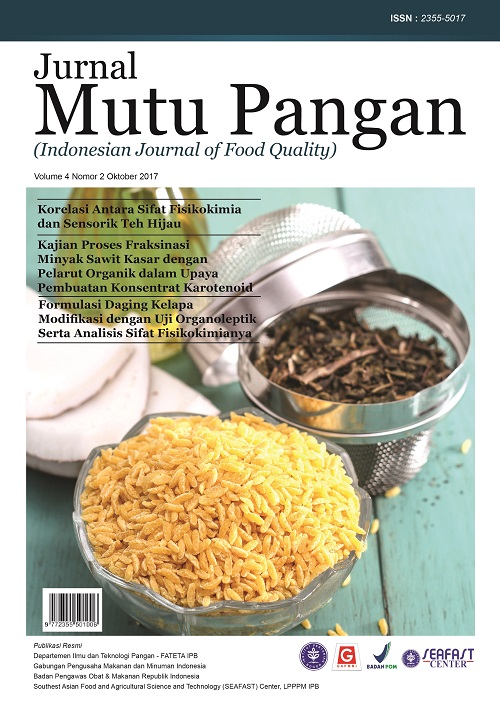Identifikasi Komponen Antibakteri Pada Ekstrak Buah Takokak Menggunakan Kromatografi Lapis Tipis
Keywords:
antibacterial, TLC, turkey berryAbstract
. Turkey berry (Solanum torvum Swartz) is one of medicinal plants and indigenous vegetables which grows abundantly in Indonesia. It has been known to have antibacterial activity against some pathogen bacteria, including Bacillus cereus. The aim of this study was to determine turkey berry’s metabolites that have antibacterial activity by TLC method. The dried turkey berry was extracted by eight different combinations of methanol and water. These extracts were then divided into two parts: for antibacterial activity analysis and for TLC analysis. Extract with good antibacterial activity and showed more spots in TLC was further identified by two-dimentional TLC. The Rf score of this extract was also compared with reference compounds. F1 extract which was extracted by methanol:water (1:0) showed the highest diameter of inhibition. It also had more TLC spots than other extracts. F1 extract was then chosen to be identified by two dimentional TLC. It showed 14 sub-spots which have maximum absorption at 200-400 nm. Some sub-spots of F1 extract also showed similar Rf score with reference compounds. Based on its TLC profile, F1 extract contain saponin, gallic acid, quercetin, myricetin, kaempferol, and apigenin. However, since TLC has limited resolution, it is possible that F1 contains other flavonoids and phenolic acids that may also responsible for its antibacterial activity.
Downloads
References
Andarwulan N, Kurniasih D, Apriady RA, Rahmat H, Rotoc AV, Bolling BW. 2012. Polyphenols, carotenoids, and ascorbic acid in underutilized medicinal vegetables. J Funct Food 4(1): 339-347. DOI: 10.1016/j.jff.2012.01.003.
Arif M, Fareed S. 2011. Pharmacognostical studies and evaluation of total phenolic and flavonoid contents of traditionally utilized fruits of Solanum torvum Sw. Ind JNPR 2(02): 218–224.
Arthan D, Svasti J, Kittakoop P, Pittayakhachonwut D, Tanticharoen M, Thebtaranonth Y. 2002. Antiviral isoflavonoid sulfate and steroidal glycosides from the fruits of Solanum torvum. J Phytochemistry 59: 459-463. DOI: 10.1016/S0031-9422(01)00417-4.
Chah KF, Muko KN, Oboegbulem SI. 2000. Antimicrobial activity of methanolic extract of Solanum torvum fruit. Fitoterapia 71: 187-189. DOI: 10.1016/S0367-326X(99)00139-2.
Cowan MM. 1999. Plant product as antimicrobial agents. Clin Microbiol Rev 12(4): 564-568. DOI: 10.1128/CMR.12.4.564.
Cushnie TPT, Lamb AJ. 2005. Antimicrobial activity of flavanoids. Int J Antimicrobiol Agents 26: 343-356. DOI: 10.1016/j.ijantimicag.2005.09.002.
Gandhi, Ignacimuthu GRS, Paulraj MG. 2011. Solanum torvum Swartz fruit containing phenolic compounds shows antidiabetic and antioxidant effects in streptozotocin induced diabetic rats. J Food Chem Tox 49: 2725–2733. DOI: 10.1016/j.fct.2011.08.005.
Harborne JB. 1973. Metode Fitokimia: Penuntun Cara Modern Menganalisis Tumbuhan, terbitan ke-1. Padmawinata K dan Soediro I, penerjemah. ITB, Bandung.
Kannan M, Dheeba B, Gurudevi S, Singh AJAR. 2012. Phytochemical, antibacterial, and antioxident studies on medicinal plant Solanum torvum. J Pharm 5(5): 2418-2421.
Khatib A, Yuliana ND, Jinap S, Sarker MZI, Jaswir I, Wilson EG, Chung SK, Verpoorte R. 2009. Identification of possible compounds possessing adenosine A1 receptor binding activity in the leaves of orthosiphon stamineus using TLC and multivariate data analysis. J Liq Chro Rel Technol 32: 2906–2916. DOI: 10.1080/10826070903297459.
Lu Y, Luo J, Kong L. 2011. Chemical constituents from Solanum torvum. Chin J Nat Med 9(1): 30-32. DOI: 10.1016/S1875-5364(11)60015-0.
Markham KR. 1988. Cara Mengidentifikasi Flavonoid. Padmawinata K, penerjemah. ITB, Bandung.
Marston A, Hotettmann K. 2006. Separation and Qualification of Flavonoids. Andersen OM, Markham KR, editor. Flavonoid: Chemistry, Bio-chemistry, and Applications. CRC Press, Boca Raton.
Ncube NS, Afolayan A, Okoh AI. 2008. Assessment techniques of antimicrobial properties of natural compounds of plant origin: current methods and future trends. Afr J Biotech 7(12): 1797-1806. DOI: 10.5897/AJB07.613.
Rammohan M, Reddy CS. 2010. Anti-inflammatory activity of seed and fruit wall extract of Solanum torvum. J Hygeia J D Med 2(2): 54-58.
Shan B, Cai YZ, Brooks JD, Corke H. 2007. Antibacterial activity of dietary spice and medicinal herb extracts. Int J Food Microb 117:112-119. DOI: 10.1016/j.ij foodmicro.2007.03.003.
Sirait N. 2009. Terong Cepoka (Solanum torvum) Herba yang berkhasiat sebagai obat. Warta Penelitian dan Pengembangan 15(3). Badan Penelitian dan Pengembangan Pertanian, Pusat Penelitian dan Pengembangan Perkebunan.
Sivapriya M, Dinesha R, Harsha R, Gowda SST, Srinivas L. 2011. Antibacterial activity of different extracts of sundakai (Solanum torvum) fruit coat. Int J Bio Chem 1-5. DOI: 10.3923/ijbc.2011.61.67.
Tajkamiri MM, Ibrahim SA, Cliver DO. 2010. Review: Antimicrobial herb and spice compounds in food. Food Con 21: 1199-1218.
Tiwari P, Kumar B, Kaur M, Kaur G, Kaur H. 2011. Phytochemical screening and extraction: A Review. Int Pharm Sci 1 (1):98-106.
Wiegand I, Hilpert K, Hancock REW. 2008. Agar and broth dilution methods to determine the minimal inhibitory concentration (MIC) of antimicrobial substances. Nat Pro 3(2): 163-175. DOI: 10.1038/ nprot.2007.521.














